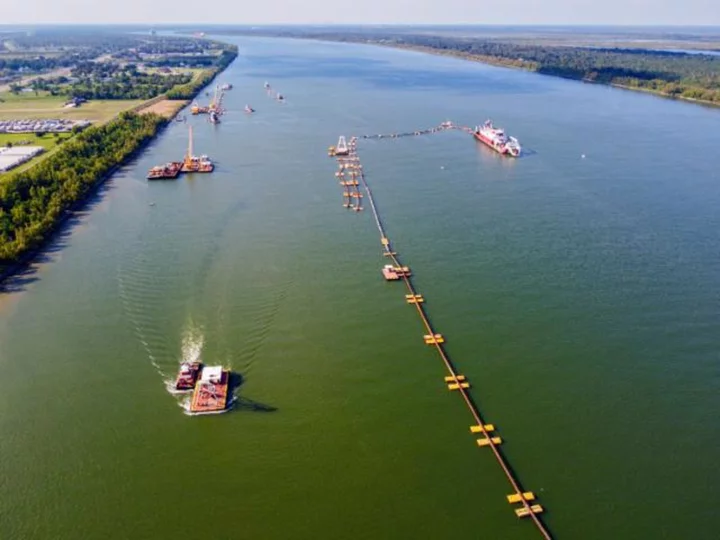Hurricanes, heat and humidity have always been looming threats on the Gulf Coast. But as drought grows in the Central US and sea level rises, residents in southern Louisiana are finding a formerly unusual emergency is becoming more frequent: saltwater is infecting drinking water city by city up the Mississippi River.
Ocean water has already polluted the drinking water for thousands of residents in Plaquemines Parish. The Army Corps of Engineers predicts it will contaminate the water systems that serve tens of thousands more residents, including those in New Orleans, in the coming weeks.
Extreme drought and sea level rise are colliding in Louisiana, and John Callahan, a climate scientist at the National Oceanic and Atmospheric Administration's center for operational oceanographic products and services, said it will only become a bigger problem in a future made hotter and drier by planet-warming pollution.
"The historic low flows on the Mississippi River right now are due to low precipitation and high temperatures," Callahan told CNN. "Droughts are expected to be more frequent if warming continues, which is expected."
For Louisiana, the future arrived this summer, as the state's deadly combo of heat, drought and fires has "basically never really occurred in living memory," Joshua Lewis, research director at Tulane University's ByWater Institute, told CNN.
"It was unlike anything I've ever experienced here before, and it does paint a very challenging picture," he said. "For residents of the region, it can feel like you're kind of waking up in a new environment every morning, and there's these new threats that emerge."
Saltwater is 'winning'
Saltwater intrusion is just another disastrous layer that the climate crisis has added to a flurry of extreme weather events. Along with blistering heat and extreme drought, Louisiana also recorded an unprecedented number of wildfires, that forced several towns to evacuate and state officials imposed a burn ban.
Retired Lt. Gen. Russel Honoré, the praised former commander of the First Army who became widely known for coordinating Hurricane Katrina relief efforts, said he never thought he'd be praying for rain at the peak of hurricane season in the Gulf.
"It's climate change. That's the dilemma we have — manmade activity is exacerbating the warming of the Earth that is causing severe changes in weather patterns," Honoré told CNN. "In all my years, I've never remembered we've gotten fire and in all my years here, I've never seen our properties' farms empty, because they have no water due to the drought."
Low flow rates on the Mississippi River can't keep saltwater from the Gulf of Mexico out. Since saltwater is denser than freshwater, it travels upstream along the bottom of the river in a wedge-like shape, infiltrating water systems as it goes.
"Saltwater from the Gulf of Mexico is always in continual contact with freshwater flow from the river," Callahan told CNN. "Right now, due to low freshwater flow, the saltwater from the Gulf is winning and is pushing farther north."
'This is not typical'
Part of the challenge this year is the river has still not recovered from the back-to-back, low-water years, said Robert Miller, a coastal hydrologist and professor at the University of Louisiana at Lafayette.
"This is not typical," Miller told CNN. "When you have a back-to-back situation, the salinity will keep creeping in. It's a buildup, it's a cumulative effect."
Past low-water years have been followed by normal wet years, he added, which brings river levels back up and dilutes the salt water.
"I think the challenge for the (Army) Corps of Engineers and other responsible institutions is to take a hard look at the procedures that are in place and be ready to respond to these kinds of back-to-back events and be able to switch modes," between flood and drought mitigation, Lewis said.
"It's going to require a lot of coordination and personnel, technology and research to be sure that we're able to respond to these events as they emerge even in back-to-back years," he added.
This emergency requires a well-planned engineering response because even if water users upstream reduced their usage, it would likely not be enough to dilute the amount of salt water currently seeping in from the Gulf. The current drought is "basin-wide," Miller said, and "everyone upstream is dealing with low water and limited supplies as well."
"The Missouri River provides water to the Mississippi, but the Missouri River is so far upstream," he said. "That water spreads out and it attenuates; even if you release a nice slug of water, its spreads out. I doubt it would do enough to push back a saltwater wedge."
With conservation unable to solve the problem, Louisiana and the Army Corps are focusing on bigger ticket items: reverse osmosis units to filter salt out of drinking water; a 55-foot-tall underwater levee to slow the spread of the saltwater wedge; a plan to barge millions of gallons of freshwater downstream to the water systems that are overwhelmed with salt.
But water barges and filtering will not be enough to prevent saltwater from contaminating New Orleans' water facilities, officials said at a meeting on Wednesday. Barring significant rainfall, a multimillion-dollar pipeline will be needed to deliver freshwater from upstream.
As expensive solutions accumulate, Miller, who is an engineer specializing in flood control, said Louisiana and other Mississippi River states have been conditioned to deal with flooding — less so with what happens when there is not enough water.
"Much of the defense has been for floods, and rightfully so," Miller said. "In my humble opinion, having worked in this area, I think [with] low water, we are maybe less prepared for dealing with that compared to floods."

